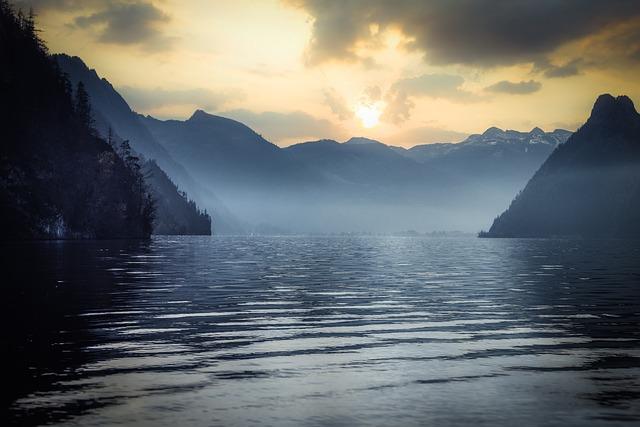In a striking revelation for scientists and nature enthusiasts alike, recent research by University College London has uncovered compelling evidence that the summit of Mafadi, the highest peak in Lesotho, was onc home to a thriving lake. This discovery comes in the form of fossilized algae, which not only shed light on the region’s geological history but also raise poignant questions about the environmental changes that have shaped the landscape over millennia. As climate dynamics and topographical shifts continue to impact ecosystems globally, understanding the conditions that allowed a lake to flourish in such an elevated and inhospitable terrain offers invaluable insights into the Earth’s climatic and ecological narrative. In this article, we delve into the significance of these findings and what they reveal about the past—and future—of Lesotho’s mountainous regions.
Understanding the Significance of fossil Algae in Lesotho’s Mafadi Summit
Fossil algae play a crucial role in unraveling the geological and environmental history of Lesotho’s Mafadi Summit. These ancient organisms serve as indicators of past ecosystems, shedding light on the climatic conditions that existed millions of years ago. By studying these fossilized remnants, scientists can piece together the narrative of a former lake that once thrived at this elevation, illustrating a time when the landscape supported diverse aquatic life. The presence of algae suggests that the region experienced favorable conditions,such as adequate moisture and stable temperatures,fostering a rich biosphere that has as dramatically transformed.
Moreover, the disappearance of this ancient lake is emblematic of significant environmental changes over time. Analyzing fossil algae also provides insights into the ecological transitions that have occurred, including shifts in climate and topography.Understanding these patterns not only enhances our knowledge of Lesotho’s geological evolution but also serves as a reminder of the fragility of ecosystems and the factors that can lead to their demise. This research underscores the importance of fossil studies in preserving the narrative of our planet’s natural history, urging us to consider the lasting impact of environmental change on biodiversity.

exploring the Geological Evolution of Mafadi Summit and Its Hidden Lakes
The Mafadi summit, the highest point in South Africa, holds a captivating narrative of geological transformation shaped by millions of years of environmental change. Recent research from University College London has uncovered fossilized algae,suggesting that a significant lake once occupied this majestic peak before it vanished. These algae serve as the remnants of a vibrant ecosystem that thrived in this alpine region, indicating that during certain climatic periods, the summit was a lush and life-supporting surroundings. The geological layers surrounding the Mafadi summit are a testament to its fluctuating landscape, shaped by tectonic movements and climatic variations that demarcate a time when water – in the form of a lake – regularly graced this area.
the examination of these ancient algae, alongside sedimentary rock analyses, helps paint a clearer picture of the hydrogeological conditions that prevailed in the past. Notably, the following elements contributed to this downfall of the summit’s lake:
Climatic Changes: Shifts in temperature and precipitation patterns likely led to evaporation and reduced water sources.
Tectonic Activities: Geological upheavals may have altered the landscape, affecting water retention capacities.
Vegetation Change: Changes in flora could have impacted moisture levels and the overall ecosystem.
To summarize the importance of this evolution and its implications, a table below outlines the critical geological timeframes and their corresponding environmental characteristics:
Geological Period
Characteristics
Paleozoic era
Formation of initial landmasses, presence of water bodies.
Mesozoic Era
Increased tectonic activity, leading to the uplift of Mafadi.
Cenozoic Era
Climatic changes resulting in the drying up of lakes.

The Role of Climate Change in the Disappearance of Ancient Lakes
The examination of fossil algae provides compelling evidence that a significant lake once thrived on the summit of Lesotho’s Mafadi, illustrating a climate that once supported diverse ecosystems. With climate change progressing at an unprecedented rate, the transformation of such environments becomes critical to comprehend. Factors contributing to the diminished presence of ancient lakes include:
Rising Temperatures: Increased global temperatures accelerate evaporation rates, leading to diminished water levels.
Altered Precipitation Patterns: Changes in rainfall distribution can result in prolonged droughts,stripping away the sustenance of these ancient water bodies.
Glacial Retreat: Melting glaciers contribute to immediate water supply changes, impacting the hydrology of surrounding lakes.
moreover, the interaction between these landscape changes and human activities exacerbates the situation. As agricultural and industrial demands increase, water is diverted, further reducing lake size and influencing local climates. A closer look at the ancient meen lake levels in the Mafadi region can be visualized in the table below:
Year
Mean Lake Level (m)
Climate Condition
Pre-1800
2100
Stable
1900
2050
Warming Trend
2000
2000
Severe Drought
2020
1950
Extreme Variability
This data not only highlights the impacts of climate change but also demonstrates the intricate relationship between natural phenomena and human influence on water resources. Without immediate intervention and enduring practices,the future of such unique geological features hangs in the balance,serving as a stark reminder of what has been lost—and what could still be if global warming remains unchecked.

Research Insights from University College London on Lake Vanishment
Recent studies conducted by researchers at university College London have uncovered significant evidence suggesting that a lake once flourished on the Mafadi summit in Lesotho. Through the analysis of ancient fossilized algae, scientists established that the area, now characterized by its rugged terrain and sparse vegetation, was once home to a vibrant aquatic ecosystem. The preserved algal remains offer a unique window into the climate and environmental conditions that prevailed thousands of years ago, providing compelling data about the historical hydrology of the region.
The research points to a series of environmental shifts that might have contributed to the disappearance of this lake. Factors identified by the research team include:
Climate Change: Fluctuations in precipitation and temperature could have altered the water balance.
Geological Activity: Movements in the Earth’s crust may have changed the landscape, redirecting water sources.
Ecological Diversification: Shifts in plant and animal species could have impacted the lake’s health and sustainability.
To visualize the timeline of these pivotal changes, the following table summarizes the key phases of lake existence and significant climatic events:
Time Period
Lake Status
Environmental Changes
~5000 years ago
Existence of Lake
Stable climate, abundant rainfall
~2000 years ago
Decline Begins
Temperature increase, decreasing precipitation
Present
No Lake
High evaporation rates, altered landscape

Preserving Geological Heritage: Recommendations for Future Research and Conservation
In light of recent findings regarding fossil algae at the Mafadi summit, it becomes imperative to consider strategies for the conservation and further research of geological sites. The unique geological heritage of such locations not only enhances our understanding of Earth’s history but also substantiates the importance of biodiversity and ecosystem evolution. To safeguard these precious resources, future initiatives may include:
Complete surveys of geological formations to identify critical areas for preservation.
Establishment of protected geological reserves that prioritize sensitive environments, such as those identified as former ecosystems.
Integrated research programs that combine geology, paleontology, and ecology to create a holistic view of past environments.
Public awareness campaigns to educate communities about the significance of geological sites and promote responsible tourism.
Moreover, collaborative efforts among academic institutions, government bodies, and local communities will be key in ensuring effective conservation practices. The following table outlines potential collaborations and their benefits:
Collaboration Type
Potential Benefits
University partnerships
Enhanced research capabilities and resource sharing.
Local Engagement
Increased community stewardship and socio-economic benefits.
international collaborations
Global knowledge exchange and funding opportunities.

Implications for Local Ecosystems and water Resource Management in Lesotho
The discovery of fossil algae on the Mafadi summit unveils significant insights into the historical hydrology of the region, shedding light on the ecological dynamics that once prevailed in Lesotho. The vanishing of the ancient lake indicates a potential shift in local ecosystems which could have had profound implications on biodiversity, habitat stability, and species migration. key factors influenced by this historical transformation include:
Loss of Aquatic Habitats: The disappearance of the lake would have reduced the availability of critical habitats for aquatic and semi-aquatic species.
Altered Microclimates: Changes in water availability can considerably impact local microclimates, thereby affecting plant and animal distributions.
Erosion and Soil Degradation: The absence of stabilizing water bodies could lead to increased soil erosion,adversely impacting land productivity.
In terms of water resource management, this historical analysis suggests a need for adaptive strategies that consider how past hydrological patterns might inform future scenarios. Given that Lesotho faces challenges related to water scarcity due to climatic variations, it becomes essential to implement sustainable management practices that address both current and historical contexts. Strategic actions could include:
Enhanced River Basin Management: Integrate findings on historical hydrology into modern water management practices.
Conservation of Water Resources: Prioritize the protection and rehabilitation of local wetlands to mitigate loss of biodiversity.
Community Engagement: Foster local community involvement in water management decisions to enhance stewardship of resources.
In Conclusion
the discovery of fossil algae on the summit of Lesotho’s Mafadi not only deepens our understanding of the region’s geological history but also highlights the dynamic nature of Earth’s environments over time. This transformative find, as reported by researchers from University College London, paints a vivid picture of a once-thriving lake that has long since disappeared. Such insights remind us of the intricate relationships between climate,biodiversity,and geological processes,prompting further investigation into how today’s ecosystems may be shaped by the lessons of the past. As scientists continue to explore the storied landscapes of lesotho, we are compelled to consider the environmental narratives etched in rock and sediment, urging us to reflect on our planet’s ever-changing climate.
Author : Olivia Williams
Publish date : 2025-02-24 05:37:00
Copyright for syndicated content belongs to the linked Source.
—-
Author : africa-news
Publish date : 2025-02-24 05:46:07
Copyright for syndicated content belongs to the linked Source.